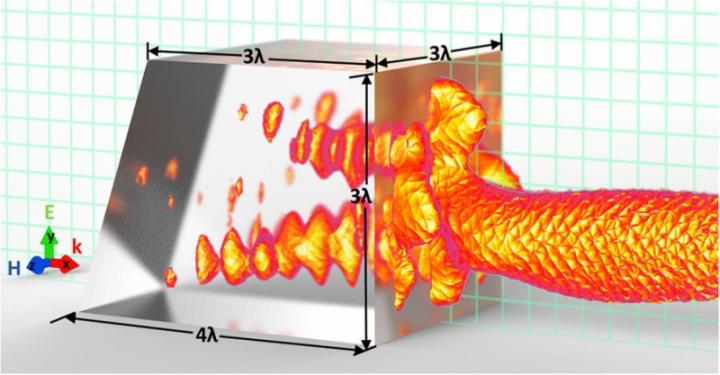Scientists invented method of catching bacteria with 'photonic hook'

This is a model of particle, hit by laser pulse, that emits new type of curved beam. Credit: ITMO University
For the longest time, physicists claimed that electromagnetic radiation propagates along a straight line; however, in 2007 the existence of a curved electromagnetic ray was experimentally confirmed. It was dubbed the “Airy beam” and, up until now, was considered a singular example of a curved ray.
Recently, scientists from ITMO University, along with their colleagues from Tomsk State University, the University of Central Florida, the University of Ben-Gurion and the University of Bangor, have discovered a new type of curved light beam – the photonic hook.
“Photonic hook is formed when we direct a plane light wave to a dielectric particle of an asymmetric shape,” says Alexander Shalin, head of the International Laboratory of Nano-opto-mechanics at ITMO University. “We studied a particle called cuboid. It has the appearance of a cube with a prism located on one side. Due to this shape, the time of the complete phase of the wave oscillations varies irregularly in the particle. As a result, the emitted light beam bends.”
Scientists showed that the photonic hook's curvature radius can be much smaller than its wavelength. The curvature can also be adjusted by varying wavelength, incident light polarization as well as geometric parameters of the emitting particle. This property can be used to redirect an optical signal, to overcome the diffraction limit in optical systems or to move individual particles on a nanoscale.
“This idea was initially suggested by our colleagues from Tomsk State University. As soon as we made the necessary calculations and described this phenomenon, we decided to check whether a photon hook can be used in optomechanics,” says Sergey Sukhov, researcher at the University of Central Florida. “It turned out that, using a photonic hook, we can make a manipulator to move particles along a curved path around transparent obstacles. This is possible due to radiation pressure and gradient optical force. When some particle hits the region of the highest intensity of the beam, the gradient force keeps it inside the beam while radiation pressure pushes it along the curved path of energy flow propagation.”
Such a method of control over particles movement is promising for optofluidics. This technology uses light beams to direct micro-streams of dissolved nano- and microparticles. This allows scientists to make micro-reactors on chips and to investigate, for example, bacteria, viruses or individual cells.
“We are now going to make an experiment and attempt to move bacteria along a curved trajectory with a photonic hook,” Alexander continues. “First of all, we need to get the hook itself in experimental conditions. We need to check, for instance, if a substrate under our cuboid would affect the hook emission. Next we will make a prototype of the micro-reactor and study how particles move.”
Theoretical basis for the upcoming experiments includes two articles that hjave already caught the scientific community's attention.
“The reference article describing the photonic hook itself was followed by an article about its optomechanical application,” Sergey comments. “Even before the first paper was published, MIT included it in its weekly review of the most interesting preprints. Yet, it also raised a lot of questions from the reviewers. Soon after it was published, it hit the top downloads on the Optics Letters website. By that time, the second article on optomechanics was accepted for printing. We hope that the results of our experiments will cause even greater interest.”
###
Reference:
Photonic hook: a new curved light beam. Liyang Yue et al. Optics Letters, Feb. 9, 2018; https:/
'Photonic Hook' based optomechanical nanoparticle manipulator. Angeleene Ang et al. Scientific Reports, Feb. 1, 2018. https:/
Media Contact
All latest news from the category: Physics and Astronomy
This area deals with the fundamental laws and building blocks of nature and how they interact, the properties and the behavior of matter, and research into space and time and their structures.
innovations-report provides in-depth reports and articles on subjects such as astrophysics, laser technologies, nuclear, quantum, particle and solid-state physics, nanotechnologies, planetary research and findings (Mars, Venus) and developments related to the Hubble Telescope.
Newest articles
Humans vs Machines—Who’s Better at Recognizing Speech?
Are humans or machines better at recognizing speech? A new study shows that in noisy conditions, current automatic speech recognition (ASR) systems achieve remarkable accuracy and sometimes even surpass human…

Not Lost in Translation: AI Increases Sign Language Recognition Accuracy
Additional data can help differentiate subtle gestures, hand positions, facial expressions The Complexity of Sign Languages Sign languages have been developed by nations around the world to fit the local…

Breaking the Ice: Glacier Melting Alters Arctic Fjord Ecosystems
The regions of the Arctic are particularly vulnerable to climate change. However, there is a lack of comprehensive scientific information about the environmental changes there. Researchers from the Helmholtz Center…



